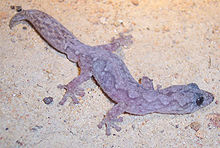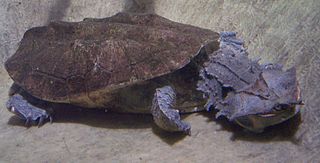
Chelidae is one of three living families of the turtle/tortoise suborder Pleurodira, and are commonly called Austro-South American side-neck turtles. The family is distributed in Australia, New Guinea, parts of Indonesia, and throughout most of South America. It is a large family of turtles with a significant fossil history dating back to the Cretaceous. The family is entirely Gondwanan in origin, with no members found outside Gondwana, either in the present day or as a fossil.
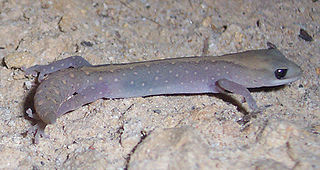
Diplodactylus is a genus of geckos of the family Diplodactylidae from Australia. They are sometimes called stone geckos or fat-tailed geckos. Member species are morphologically similar but genetically distinct.

Oedura is a genus of medium to large geckos, lizards in the family Diplodactylidae. The genus is endemic to Australia. Species in the genus are referred to by the common name velvet geckos.
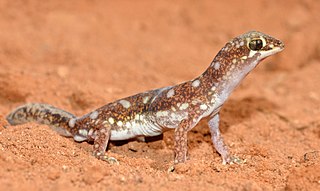
Rhynchoedura, also known as the beaked geckos, is a genus of lizards in the family Diplodactylidae endemic to Australia. It includes six species:

Crenadactylus, the clawless geckos, are named for their distinguishing feature, the absence of terminal claws on the digits. They are the only Australian members of Gekkonidae to lack claws, the endemic genus is also the smallest in size.

Amalosia lesueurii, commonly known as Lesueur's gecko or Lesueur's velvet gecko, is a species of gecko, a lizard in the family Diplodactylidae. The species is endemic to Australia.

The Diplodactylidae are a family in the suborder Gekkota (geckos), with about 137 species in 25 genera. These geckos occur in Australia, New Zealand, and New Caledonia. Three diplodactylid genera have recently been split into multiple new genera
Lucasium byrnei, commonly known as the gibber gecko or Byrne's gecko, is a species of small, nocturnal gecko, a lizard in the family Diplodactylidae. The species is endemic to Australia.
Lucasium stenodactylum, also known as the crowned gecko or pale-snouted ground gecko, is a species of gecko from Australia.
Amalosia jacovae, also known as the clouded gecko, is a species of gecko, a lizard in the family Diplodactylidae. The species is endemic to Australia.

Main's ground gecko is a species of gecko, a lizard in the family Diplodactylidae. The species is endemic to Australia.
The Pilbara ground gecko also known commonly as Wombey's gecko, is a species of lizard in the family Diplodactylidae. The species is endemic to Australia.
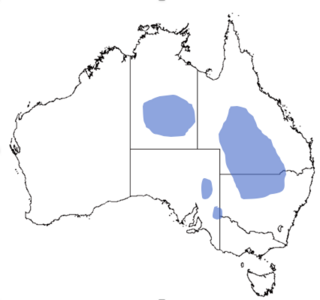
Oedura cincta, or inland marbled velvet gecko, is an Australian species of gecko.
Strophurus horneri, also known commonly as the Arnhem phasmid gecko, is a species of lizard in the family Diplodactylidae. The species is endemic to Australia.
The short-tailed striped gecko, also known commonly as McMillan's spiny-tailed gecko, is a species of lizard in the family Diplodactylidae. The species is endemic to Australia.
Strophurus robinsoni is a species of gecko, a lizard in the family Diplodactylidae. The species is endemic to Australia.
Strophurus taeniatus, also known commonly as the phasmid striped gecko or the white-striped gecko, is a species of lizard in the family Diplodactylidae. The species is endemic to Australia.

Strophurus williamsi, also known commonly as the eastern spiny-tailed gecko, the soft-spined gecko, and Williams' spiny-tailed gecko, is a species of lizard in the family Diplodactylidae. The species is endemic to semi-arid regions of eastern Australia including Queensland, New South Wales, Victoria and South Australia. it has become a popular species as a pet for its distinctive tail features. S.williamsi has been grouped within a clade of seven other species that are believed to have diverged from their ancestors around 16 million years ago S.williamsi can be distinguished from closer relatives by arboreality and diurnal (day-active) activity.

Pygopodoidea is a gecko superfamily and the only taxon in the gekkotan subclade Pygopodomorpha. The clade includes three Australasian families: Diplodactylidae, Carphodactylidae, and Pygopodidae. Traditional gekkotan systematics had considered Diplodactylidae and Carphodactylidae as subfamilies of the family Gekkonidae, but recent molecular work have placed Pygopodidae within Gekkonidae making it paraphyletic. These analyses have shown support of Pygopodidae and Carphodactylidae being sister taxa, with Diplodactylidae occupying a basal position in Pygopodoidea.
Oedura picta, the ornate velvet gecko, is a species of gecko endemic to Queensland in Australia. It, along with two other species, was first formally named in 2019.
